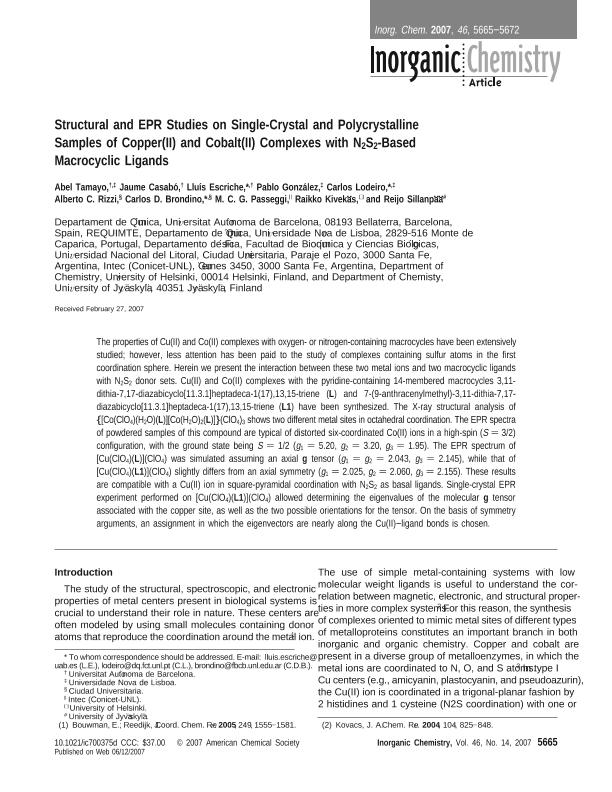Artículo
Structural and EPR Studies on Single-Crystal and Polycrystalline Samples of Copper(II) and Cobalt(II) Complexes with N2S2-Based Macrocyclic Ligands
Tamayo, Isabel Cristina; Casabó, Jaume; Escriche, Lluís; González, Pablo Javier ; Lodeiro, Carlos; Rizzi, Alberto Claudio; Brondino, Carlos Dante
; Lodeiro, Carlos; Rizzi, Alberto Claudio; Brondino, Carlos Dante ; Passeggi, Mario Cesar Genaro
; Passeggi, Mario Cesar Genaro ; Kivekäs, Raikko; Sillanpää, Reijo
; Kivekäs, Raikko; Sillanpää, Reijo
 ; Lodeiro, Carlos; Rizzi, Alberto Claudio; Brondino, Carlos Dante
; Lodeiro, Carlos; Rizzi, Alberto Claudio; Brondino, Carlos Dante ; Passeggi, Mario Cesar Genaro
; Passeggi, Mario Cesar Genaro ; Kivekäs, Raikko; Sillanpää, Reijo
; Kivekäs, Raikko; Sillanpää, Reijo
Fecha de publicación:
12/2007
Editorial:
American Chemical Society
Revista:
Inorganic Chemistry
ISSN:
0020-1669
Idioma:
Inglés
Tipo de recurso:
Artículo publicado
Clasificación temática:
Resumen
The properties of Cu(II) and Co(II) complexes with oxygen- or nitrogen-containing macrocycles have been extensively studied; however, less attention has been paid to the study of complexes containing sulfur atoms in the first coordination sphere. Herein we present the interaction between these two metal ions and two macrocyclic ligands with N2S2 donor sets. Cu(II) and Co(II) complexes with the pyridine-containing 14-membered macrocycles 3,11-dithia-7,17-diazabicyclo[11.3.1]heptadeca-1(17), 13,15-triene (L) and 7-(9-anthracenylmethyl)-3,11-dithia-7,17-diazabicycio[11.3.1]heptadeca- 1(17),13,15-triene (L1) have been synthesized. The X-ray structural analysis of {[Co(ClO4)(H2O)(L)][Co(H2O)2(L)]} (ClO4)3 shows two different metal sites in octahedral coordination. The EPR spectra of powdered samples of this compound are typical of distorted six-coordinated Co(II) ions in a high-spin (S = 3/2) configuration, with the ground state being S = 1/2 (g1 = 5.20, g2 = 3.20, g3 = 1.95). The EPR spectrum of [Cu(ClO4)(L)] (ClO4) was simulated assuming an axial g tensor (g1 = g2 = 2.043, g3 = 2.145), while that of [Cu(ClO 4)(L1)](ClO4) slightly differs from an axial symmetry (g1 = 2.025, g2 = 2.060, g3 = 2.155). These results are compatible with a Cu(II) ion in square-pyramidal coordination with N2S2 as basal ligands. Single-crystal EPR experiment performed on [Cu(ClO4)(L1)](ClO4) allowed determining the eigenvalues of the molecular g tensor associated with the copper site, as well as the two possible orientations for the tensor. On the basis of symmetry arguments, an assignment in which the eigenvectors are nearly along the Cu(II)-ligand bonds is chosen.
Palabras clave:
EPR
,
Cu(II) and Co(II)
,
complexes
Archivos asociados
Licencia
Identificadores
Colecciones
Articulos(CCT - SANTA FE)
Articulos de CTRO.CIENTIFICO TECNOL.CONICET - SANTA FE
Articulos de CTRO.CIENTIFICO TECNOL.CONICET - SANTA FE
Citación
Tamayo, Isabel Cristina; Casabó, Jaume; Escriche, Lluís; González, Pablo Javier; Lodeiro, Carlos; et al.; Structural and EPR Studies on Single-Crystal and Polycrystalline Samples of Copper(II) and Cobalt(II) Complexes with N2S2-Based Macrocyclic Ligands; American Chemical Society; Inorganic Chemistry; 46; 14; 12-2007; 5665-5672
Compartir
Altmétricas



